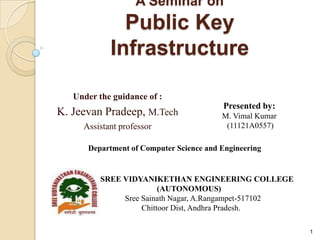
public key infrastructure
- 1. A Seminar on Public Key Infrastructure Under the guidance of : K. Jeevan Pradeep, M.Tech Assistant professor 1 Presented by: M. Vimal Kumar (11121A0557) SREE VIDYANIKETHAN ENGINEERING COLLEGE (AUTONOMOUS) Sree Sainath Nagar, A.Rangampet-517102 Chittoor Dist, Andhra Pradesh. Department of Computer Science and Engineering
- 2. Contents Introduction to Access Control Policy Password Authentication Symmetric and Asymmetric Encryption Hashing Digital Signature Public Key Infrastructure Certification Validation Revocation Authentication Keys Related Technologies Conclusion References 2
- 3. Introduction to Access Control Policy To be able to access data and applications from within a company, a user first needs to be authenticated, and then needs to be authorized to perform the operation. Authentication Procedures perform the former task, and Access Control Decision functions perform the later task.
- 4. Password Authentication When a company has several applications hosted by different systems and servers, there are several ways of identity authentication. Multiple passwords, one for each system/application Same password, replicated in each system Single sign-on software Directory Server
- 5. Symmetric and Asymmetric Encryption The objective of encryption is to transform a message to a cipher text, ensuring confidentiality In the symmetric encryption schemes the same key (called the secret key) is used to both encrypt and decrypt the text. Ex :- DES algorithm. Asymmetric cryptosystems use one key (the public key) to encrypt a message and a different key (the private key) to decrypt it. Ex:- RSA and ECDSA algorithms.
- 6. Contd… • Comparison between symmetric and asymmetric encryption
- 7. Hashing Hashing is the method used to obtain a "digital fingerprint" (hash) for a given message. The hash code has a fixed-length (normally 128 or 160 bits) and it's designed to be unique Some examples are MD2, MD4, MD5 (128 bits) and SHA1 (Secure Hash Algorithm,160 bits )
- 8. Digital Signature To obtain a secure digital signature, At first the message is hashed Creating a digital fingerprint which is encrypted using the receiver's public key Creating a digital signature. The clear message is combined with the digital signature The result (an authenticated message) is sent After the reception, the message is separated from the digital signature which is decrypted using the receiver's private key The message is hashed into a "temporary" digital fingerprint which is used to validate the received fingerprint If the message has not been modified during the transfer process, it's authenticated.
- 10. Public Key Infrastructure Three different formats of messages can be used in public- key cryptosystems: Encrypted message, Signed message, Signed and encrypted message. An infrastructure must be set-up to allow them to be undoubtedly trusted , as they are accessible via unsecured networks (Internet) PKI entities: -CA ( certification authority ) -RA ( registration authority ) -Subscriber -Relying Party -Repository
- 11. PKI basic entities and operations
- 12. Certification Certification is the fundamental function of all PKIs. The certificates provide a secure way of publishing public keys, so that their validity can be trusted. A certificate contains (at least) the basic information needed to provide a third party entity with the subject's public key: • Subject Identification information • Subject public Key • CA Identification Information • Validity (e.g. time)
- 13. Certification contd... Cross certification :- Not all the entities will trust the same CA to hold their certificates. Cross certification is used to create the certificate between two CAs. If both CAs trust each other, a cross certificate pair is established. In other cases, only one certificate would be created, and not a pair.
- 14. Certification contd... Certification path :- In a universe composed of several different CAs an arbitrary number of CAs must validate each other, until a certificate is obtained. This process is called certification path validation.
- 15. Validation This is the process that ensures that the certificate information is still valid, as it can change over time. Either the user can ask the CA directly about the validity - every time it's used - or the CA may include a validity period in the certificate. This second alternative is also known as offline validation.
- 16. Revocation This is the process of informing the users when the information in a certificate is not valid. This is especially interesting in the absence of online validation approaches, and the most common revocation methods consist in publishing Certification Revocation Lists (CRL). A CRL is a "black" list of revoked certificates that is signed and periodically issued by a CA.
- 17. Authentication In order for the subject to gain access to its private key, it has to possess a smart card or an encrypted key file and know something (PIN or password) or be something (e.g. a particular fingerprint).
- 18. Keys Key pair models :- To increase the security level, different key pairs might exist for different functions, which may be divided into the following categories: • Non-repudiatable message signing (e.g. e-mail). • Encryption/Decryption functions. • Authentication only (e.g. LOG ON functions).
- 19. Key Management These are the main steps performed in a PKI structure to handle the key pairs: •Key Generation •Storage of Private Keys •Revocation of Public Keys •Publication of certificates and CRL •Key Update •Backup / Recovery •Escrow / Recovery
- 20. Related Technologies CMS - Cryptographic Message Syntax SSL Secure e-mail / S/MIME VPN (Virtual Private Network) PGP (Pretty Good Privacy)
- 21. Conclusion RFC 2822(Internet Security Glossary) defines public-key infrastructure(PKI) as the set of hardware , software , people , policies and procedures needed to revoke digital certificates based on asymmetric cryptography. The principal objective for developing a PKI is to enable secure , convenient and efficient acquisition of public keys.
- 22. References Wikipedia www.studymafia.com Network Security Essentials -by William Stallings 23
- 23. QUERIES…???
- 24. THANK YOU